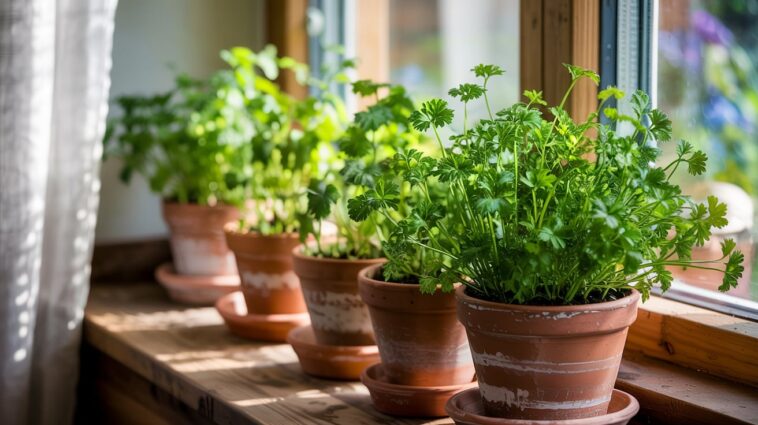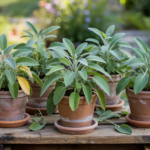When I was growing up, parsley was just a garnish I ignored. Now, it’s the main attraction in my kitchen. Growing parsley in pots is easy and changes the game for home cooks and gardeners. You can have fresh leaves all year, even in tiny spaces.
This herb loves pots, doing well in sun or partial shade. It also gets along with herbs like rosemary or thyme in mixed containers.
Container gardening lets you control soil and water, keeping roots healthy. Make sure your pots have drainage holes. This prevents soggy roots. I’ve seen parsley grow well in 12-inch pots, spaced 6 inches apart, with garlic or onions to keep pests away.
Starting is easy, whether from supermarket seedlings or seeds soaked before sowing. In Florida, I plant parsley in fall for winter growth. It adapts to many climates. By following these basics, you’ll have a steady supply of this nutrient-rich herb. Let’s explore how to make it thrive, from choosing the right pot to harvesting those flavorful leaves.
Why Growing Parsley in Containers Makes Sense
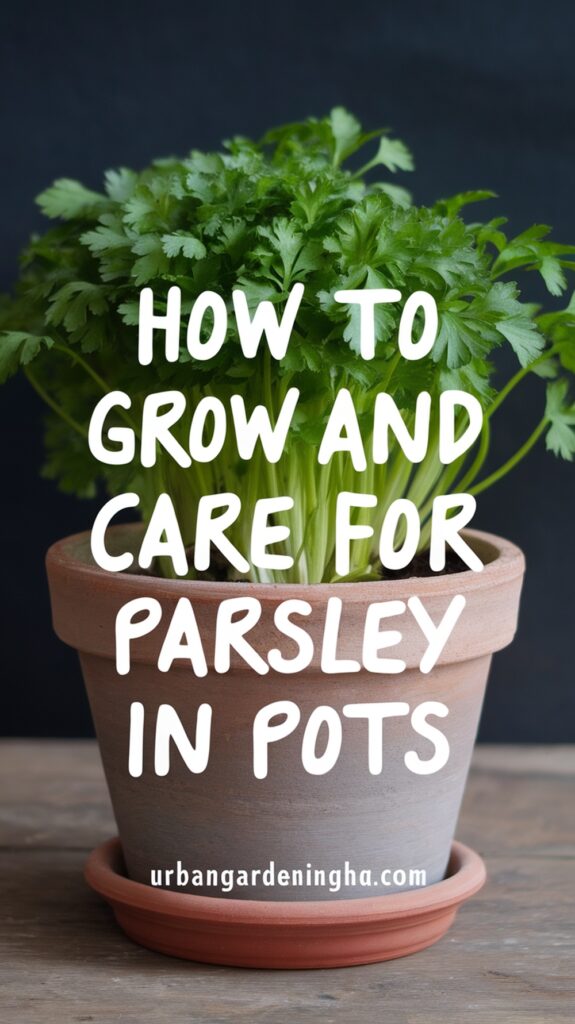
Container gardening turns small spaces into herb oases. Parsley grows well in pots, perfect for city dwellers or those with tiny yards. This method is great for home gardeners.
Benefits of Container Gardening for Herbs
Container gardening gives you control over soil and moisture. You can move plants for better light or to protect them from frost. This method also keeps pests away and reduces disease risks.
Planting parsley with other herbs in big pots creates a mini garden. It’s a great way to use small spaces.
Year-round Access to Fresh Parsley
Grow parsley indoors all year by moving it to sunny windowsills in winter. Even small kitchens can support parsley with a south-facing window. Containers let you harvest parsley beyond the usual growing seasons.
Keep plants watered and use organic fertilizers for year-round growth. This way, you’ll always have fresh parsley.
Space-saving Solutions for Any Home
No backyard? No problem. Parsley fits in any space. Here’s how to make the most of it:
| Space | Container Ideas | Tip |
|---|---|---|
| Windowsill | Small clay pots | Rotate weekly for even light exposure |
| Balcony | Vertical planters | Use drip trays to catch excess water |
| Countertop | Compact self-watering pots | Pair with herbs like thyme for shared space |
Even small pots, 8 inches deep, are good for single plants. Larger ones let you mix parsley with mint or chives. Whether on a desk or balcony, parsley can thrive in any space.
Choosing the Right Parsley Variety for Container Growing
When picking parsley for pots, decide between curly and flat-leaf types. Curly parsley (Petroselinum crispum) grows well in containers, reaching 8–14 inches tall. Its leaves add a lively touch to dishes or window boxes.
For How to Grow and Care for Parsley in Pots, choose ‘Evergreen Giant’ or ‘Extra Curly’. They stay small and don’t bolt easily in tight spaces.
Flat-leaf parsley (P. neapolitanum), like ‘Italian Giant’ or ‘Moss Curled’, grows taller (up to 3 feet). It needs bigger pots. Its strong flavor makes it a favorite in the kitchen.
Japanese parsley (Cryptotaenia japonica), though less common, has a unique anise-like taste. It’s great for Asian dishes. It grows well in pots but prefers partial shade.
- Curly parsley: Best for decoration; tolerates cooler temps
- Flat-leaf: Stronger taste; ideal for cooking
- Japanese: Unique flavor; niche uses
Seed germination takes 2–3 weeks. Consider nursery seedlings for quicker results. Look for healthy stems and no yellow leaves.
For parsley care tips, always check soil moisture before planting. Dwarf varieties like ‘Compacta’ are perfect for small spaces. Tall types need at least 12-inch-deep pots. Try both types to find your favorite!
How to Grow and Care for Parsley in Pots: The Basics
Learning parsley care tips starts with picking the right type and tools. Here’s what you need to know for growing parsley in pots.

Flat-leaf vs. Curly Parsley: Which Grows Better in Containers
Flat-leaf parsley grows well in small spaces and tastes great. Curly types look nice but need more care. Both can grow in pots, but flat-leaf is easier for beginners.
Curly parsley needs regular trimming to stay small. Flat-leaf parsley is more forgiving with less care.
Understanding Parsley’s Growth Cycle
Parsley grows for two years, but most people grow it as an annual. This keeps the leaves fresh. To keep it going, replant every year.
To protect it from cold, mulch the roots with shredded leaves. Use row covers in zones 4-5+.
Essential Tools and Supplies for Container Parsley
- Containers with drainage holes (minimum 8-inch depth for taproots)
- Well-draining potting soil mixed with compost
- Watering can with a gentle spout to avoid seedling damage
- Pruning shears for harvesting and shaping
- Mulch materials like straw or shredded bark
Don’t forget a mister for seedlings and organic fertilizer for regular feeding. A 10-inch pot is best for 6-inch spacing between plants.
Selecting the Perfect Container for Your Parsley Plants
Finding the right container is key for parsley plants to thrive. I learned that the size and material of the pot affect the roots and growth. Let’s explore what’s best.
Ideal Parsley Pot Size and Depth
A 6-inch-wide pot is good for one parsley plant, but it needs to be 8–10 inches deep for the taproot. For three plants, a 12×12-inch container is best to allow the roots to spread. I recommend 3–5-gallon pots for a balance of space and ease of moving.
Small pots can stunt growth because of cramped roots. Place smaller containers on window sills, making sure they fit well.
Material Matters: Clay, Plastic, or Ceramic?
Clay pots dry out faster, so I water them more often. Fabric grow bags are good for air but need frequent watering. Ceramic pots hold moisture longer but are heavier.
Choose based on your climate. Plastic pots are easy to care for, making them perfect for beginners.
Drainage Requirements for Healthy Parsley
- Ensure pots have multiple drainage holes—no exceptions.
- Add a layer of gravel or broken pots at the base to improve water flow.
- Use a saucer under the pot to catch runoff, but empty it daily.
- Mix soil with sand to enhance drainage; avoid garden soil.
I always use store-bought potting mix for containers—it’s light and drains better than garden soil. Good drainage prevents root rot, a major parsley killer.
Soil and Planting: Setting Up Your Parsley for Success
For parsley to thrive in pots, the right soil is key. Mix commercial potting soil, compost, and perlite to prevent waterlogging. This blend keeps roots oxygenated and moist.
- Mix 60% potting soil with 25% compost, 10% perlite, and 5% coarse sand.
- Ensure pH stays between 5.5 and 6.7 for optimal growth.
- Soak seeds overnight in lukewarm water to boost germination rates.
| Component | Percentage |
|---|---|
| Commercial Potting Mix | 60% |
| Compost | 25% |
| Perlite | 10% |
| Coarse Sand | 5% |
Plant seeds ¼ inch deep, 6–8 inches apart. Bury seedlings 1 inch deeper than their nursery pots. Water gently to settle the soil. Parsley likes loose, loamy soil, not compact garden soil.
Water and Sunlight: The Perfect Balance for Potted Parsley
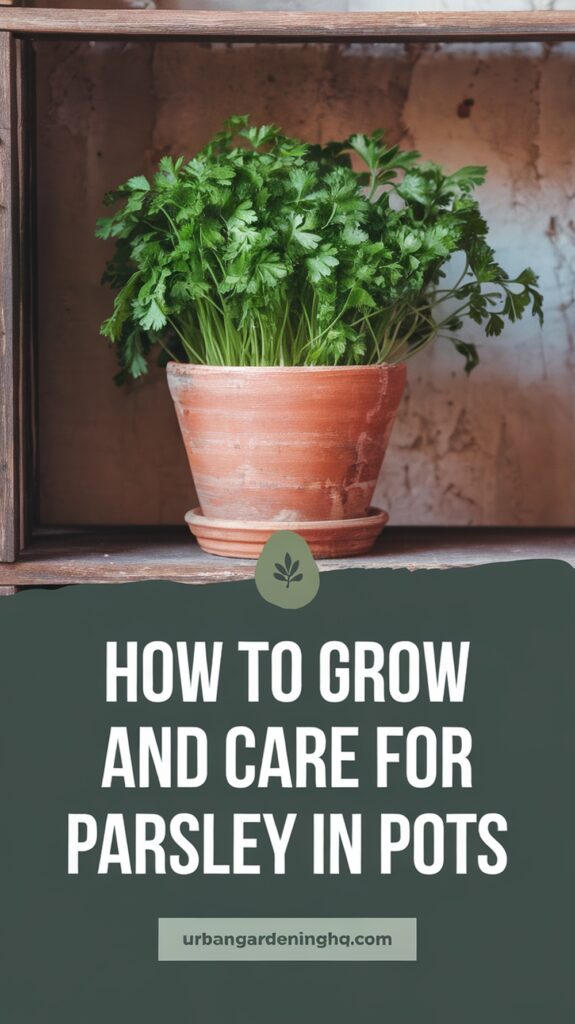
Getting the right mix of water and light is key for your potted parsley. It needs the right amount of water and sunlight to thrive. A good potting mix, like Miracle-Gro® Performance Organics® All Purpose Container Mix, helps keep the soil just right.
Adjusting your care based on the season and where you live is important. This ensures your parsley stays healthy and productive.
Watering Schedule for Container-Grown Parsley
Check if the soil is dry by sticking your finger into it. If the top inch is dry, it’s time to water. Make sure the water drains well from the pot.
Water more often when it’s hot and dry outside. Don’t let the soil dry out completely to prevent the parsley from wilting.
- Use pots with drainage holes to prevent root rot
- Mulch soil surface with compost to retain moisture
- Reduce watering in winter when growth slows
Sunlight Needs for Year-Round Growth
Parsley loves 6-8 hours of sunlight a day. But, it also needs some shade in the afternoon, depending on where you live. If it’s too sunny, it can get scorched.
Rotate your pots every week to get even sunlight. If it’s too dark indoors, use LED grow lights for 12-14 hours a day.
- Place south-facing windowsills in winter
- Avoid direct noon sun in summer to prevent scorching
- Adjust placement seasonally to match daylight changes
Air Circulation and Humidity Tips
Keep your parsley plants 8-12 inches apart for better air flow. Mist them lightly in dry places, but don’t get the crown wet. Use pebble trays to increase humidity without overwatering.
This helps keep your parsley healthy and happy, with the right amount of moisture.
Maintenance and Care: Fertilizing, Pruning, and Pest Control
Caring for parsley in pots requires regular attention. You need to fertilize, prune, and check for pests to keep your plants healthy. Here’s how to do it:
Organic Fertilizing Schedule for Potted Parsley
I use a balanced 10-10-10 NPK fertilizer every 4-6 weeks. Mix compost into the soil when you plant. For liquid feeds, dilute it to half strength to avoid harming the roots.
Brands like Dr. Earth All Purpose or Joyful Dirt All Purpose are good choices. As your plants grow, switch to a 10-5-5 NPP blend. This keeps your plants from lacking nutrients.
Proper Trimming Techniques to Promote Bushier Growth
Trimming parsley in pots makes it fuller. Cut the outer leaves when the plant has three stems, leaving two-thirds to grow back. Always remove no more than 30-50% at a time.
Snip stems near the base to encourage new growth and prevent the plant from going to seed too soon.
Common Pests and Diseases in Container Parsley
Aphids and leafminers can be a problem. For these, I use neem oil or insecticidal soap. Root rot from too much water is another issue. Always check the drainage holes.
Planting chives nearby can help keep pests away. Ladybugs and lacewings are also good at controlling insects.
By following these steps, your parsley will stay healthy and productive. Adjust your feeding and pruning as needed based on how your plants are doing.
Harvesting Your Container-Grown Parsley
Knowing when and how to harvest parsley is important. Start picking leaves when plants are 6–8 inches tall with three leaf clusters. Good parsley care tips help you get the most from your herbs without harming the plant.
- Snip outer stems at the base with clean scissors. Cut no more than a third of the plant at once to avoid stressing it.
- Harvest in the morning after dew dries for the best flavor. Always leave inner stalks intact to encourage new growth.
- In year one, focus on leafy harvests. By the second year, the plant focuses energy on flowering and roots, so roots can be harvested in fall for storage.
Growing parsley indoors during colder months lets you extend harvests. Bring pots inside before frost and provide bright light. Even in winter, you’ll get a few leaves if placed near a sunny window. For continuous harvests, start new seeds every 4–6 weeks. Microgreens can be harvested just two weeks after sowing for quick flavor boosts.
Cut the thickest stems first to encourage bushier growth. Overharvesting weakens the plant, so let it rest 2–3 weeks between cuts. If your plant shows yellowing or slow growth, it’s time to replace it with fresh seedlings. Keep pruning tips high to prevent a woody stem buildup.
Conclusion: Enjoying the Rewards of Your Potted Parsley Garden
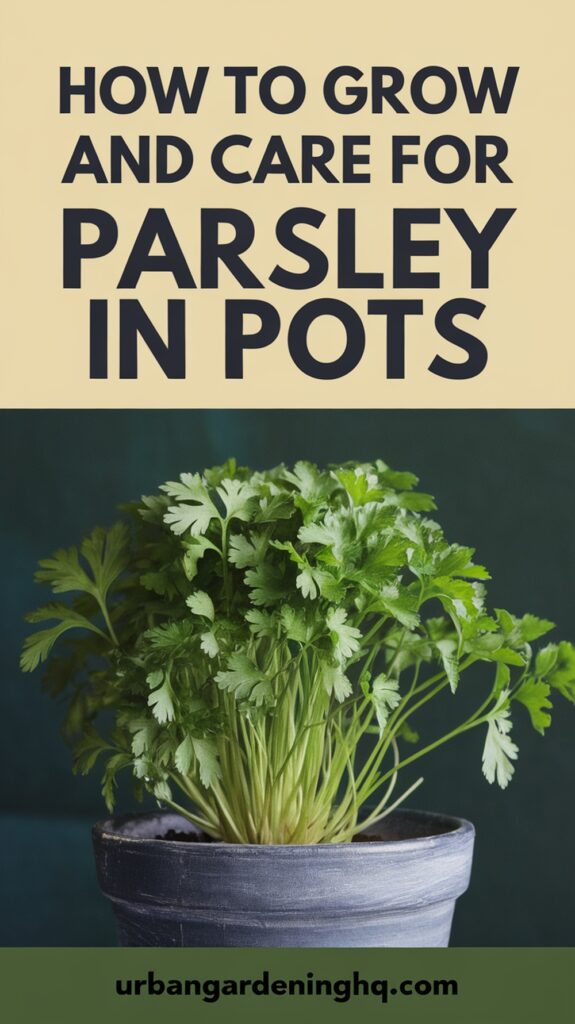
Growing parsley indoors or in containers brings fresh herbs to every meal. Imagine adding vibrant leaves to salads, soups, or marinades. You’ll know you grew them yourself.
This herb is more than a garnish. It’s a key player in dishes like zesty chimichurri or tangy tabbouleh. It adds vitamin-rich flavor to any dish.
Harvesting regularly keeps your plant healthy. You can freeze chopped leaves in olive oil cubes or dry them for later. Even the root adds depth to soups or roasted dishes.
By the second year, let some plants go to seed. This way, you can collect seeds for next season’s pots.
Container gardening lets you move plants indoors during winter. This ensures you have herbs all year. Whether cooking, making teas, or trying infusions, homegrown parsley makes meals better.
It’s perfect for small spaces and indoor setups. So, anyone can grow this superfood herb, no garden needed.
Every sprig you clip brings joy. It shows the happiness in growing something small that gives so much. With little effort, parsley becomes a kitchen staple. It reminds you of the joy in care and flavor. Happy growing—your next recipe’s secret ingredient starts right here in your pot.
